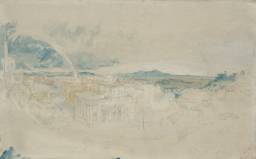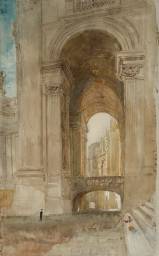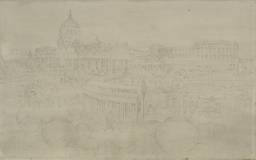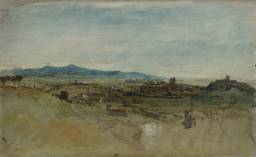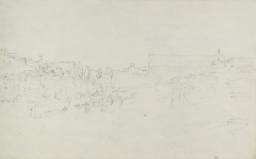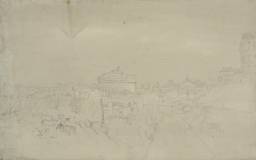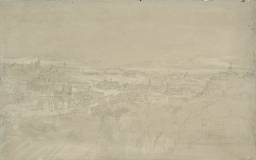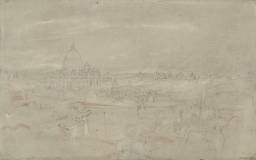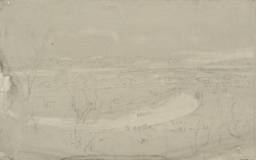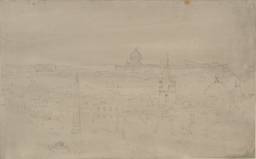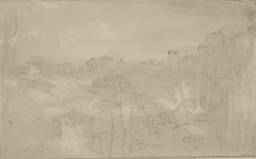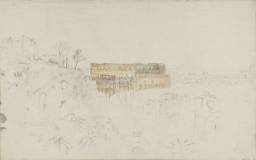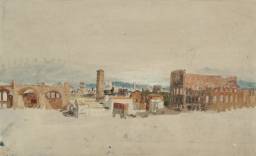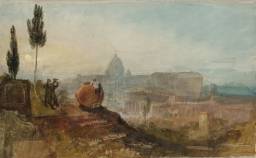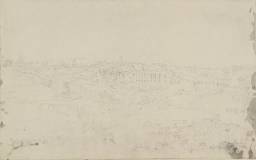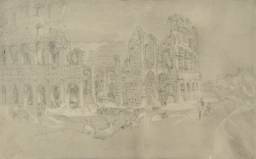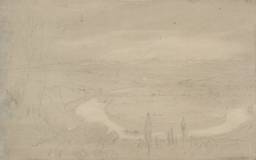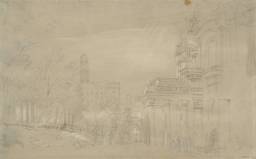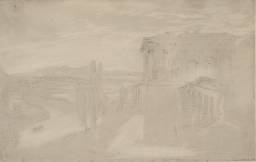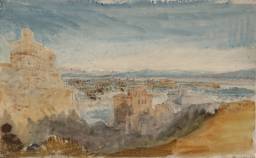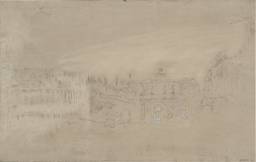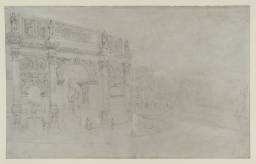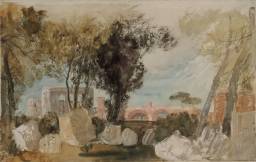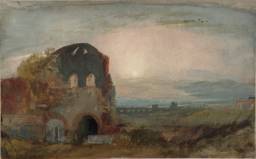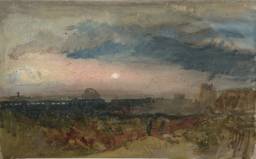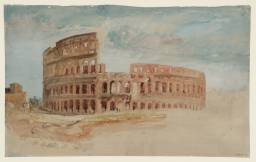Turner Bequest CLXXXIX
Sketchbook with paper covered boards bound with a tan leather spine, and two brass clasps [missing]
62 leaves of two types of white wove writing paper, approximate page size 229 x 368 mm. See Technical notes at the end of the introductory text..
62 leaves of two types of white wove writing paper, approximate page size 229 x 368 mm. See Technical notes at the end of the introductory text..
Front cover is stamped in black ‘CLXXXIX.’ top left and label on spine inscribed by the artist in black ink ‘Rome C St’ partially missing (see D40855).
Inside front cover inscribed in black ink ‘No.180 | George Jones’ and initialled in pencil by the Executors of the Turner Bequest, Charles Lock Eastlake ‘C.L.E.’ and John Prescott Knight, ‘JPK’. Inscribed by ‘AMH’ in pencil ‘Rebound 1935 | blank leaves inserted | indicating mounted drawings’ upper left and ‘Rome: C. Studies’ top right. Also inscribed by unknown hands in pencil ‘L14’ and in black ink ‘CLXXXIX’ top right.
Stamped in black ‘CLXXXIX’ top right.
Stamped in black ‘CLXXXIX’ top right.
Accepted by the nation as part of the Turner Bequest 1856
References
Turner used this sketchbook during his first tour of Italy in 1819, one of twenty-three related to that trip. The book contains studies of various subjects in Rome, many of which are executed over a washed grey background with the addition of watercolour, gouache or pen and ink. It is one of nine sketchbooks employed during his stay in the city, which aside from some weeks spent travelling to Naples and Paestum, lasted between early October to December or early January 1820.1 The title of the book follows Turner’s own handwritten label ‘14. Rome: C. Studies’ (see D40855).2
Unlike the sketchbook drawings which Turner produced en route between destinations, the material documenting his exploration of Rome does not follow an easily traceable route around the city. Instead the artist seems to have employed several books simultaneously, interchanging different formats and types of papers according to his artistic intent, and to whichever came most readily to hand at any given moment. Some of the studies within this sketchbook repeat views or sites represented elsewhere, but with greater attention to detail, for example the views from the Janiculum (D16378; CLXXXIX 49), or with atmospheric or tonal effects more fully realised, for example the view of the Forum with a rainbow (D16375; CLXXXIX 46), the interior of the Colosseum by moonlight (D16339; CLXXXIX 13), or the Temple of Minerva Medica at sunset (D16362–3; CLXXXIX 35–6). Other sketches, meanwhile, represent his only known visual record of a particular location, for example the portico of St Peter’s (D16332; CLXXXIX 6), or the view of Castel Sant’Angelo from the Vatican (D16336; CLXXXIX 10). The principal themes covered within the book include: views from the Janiculum Hill, Monte Mario and the Villa Barberini; the Roman Forum; the Colosseum; views of, or from, the Palatine Hill; the Pincian Hill including the view towards Trinità dei Monti, and the Casino di Raffaello near the Borghese Gardens; St Peter’s; and the Temple of Minerva Medica.
The ‘C’ in the title of this sketchbook, and the Naples: Rome C. Studies and Small Roman C. Studies sketchbooks, has been frequently interpreted in the past as meaning ‘Colour’, referring to the use of watercolour to develop some of the studies within. Alternatively, as Finberg believed, it may stand for ‘Chiarascuro’, reflecting the numerous tonal drawings employing pencil and white highlights over a washed grey background.3 However, Cecilia Powell has plausibly suggested that the ‘C’ might also be interpreted as ‘Composition’, since all of the relevant books contain carefully structured designs which could be intended for further development, or which relate to later watercolours and oils.4 Indeed drawings from the Rome: C. Studies sketchbook can be directly linked to several finished compositions including: Rome, from the Vatican exhibited 1820 (Tate, N00503),5 (see D16368; Turner Bequest CLXXXIX 41); Forum Romanum exhibited 1826 (Tate, N00504),6 (see D16370; Turner Bequest CLXXXIX 43); Rome, from Monte Mario circa 1820–1 (private collection),7 (see D16357; CLXXXIX 31); Rome, San Pietro in Montorio circa 1820–1 (Courtauld Institute of Art, London),8 (see D16328; CLXXXIX 2); and Rome: the Colosseum 1820 (British Museum, London),9 (see D16349; CLXXXIX 23). The high number of various other recurring subjects indicates that Turner was also seriously exploring the potential of views from the Villa Barberini, the Palatine Hill, the Pincian Hill, and the interior of the Colosseum.
The use of colour within the book has made the contents amongst the most admired and widely discussed of Turner’s sketches, and there has been much speculation about whether they were painted en plein air. The free, textured handling and luminous effects of much of the paint application appears to denote a spontaneous and instinctive reaction to the motif. However, other studies contain delicate areas of finish or more subtle effects such as liquid wet-in-wet washes. The idea that some of the views may have been coloured outside originated with John Ruskin. He suggested that it was ‘just possible’ that two views of the so-called Temple of Minerva Medica were painted on the spot owing to their ‘hasty’ and ‘careless’ appearance.10 However, Ruskin more commonly believed that Turner ‘hardly ever sketched a colour effect except from memory’ but ‘almost always wrote the colours down in words, and laid in the effect at home’.11 This is consistent with other contemporary reports. According to a letter by John Soane’s son, who was in Italy at the same time as Turner, the artist reportedly said that ‘it would take up too much time to colour in the open-air, he could make 15 or 16 pencil sketches to one colored’.12 Another point in favour of the works being painted indoors is the wide range of media used throughout the sketchbook. It is extremely unlikely that Turner would have carried around with him pencil, watercolour, gouache, pen and ink and chalk, as well as the equipment necessary for lifting, scratching or rubbing through the grey wash to achieve highlights. As Cecilia Powell has also discussed, Turner would hardly have sat painting in the busier parts of the Rome, and many of landscapes documenting atmospheric conditions, such as moonlight, or rainbows just after a shower, could not possibly have been coloured in situ.13
Many of the tonal studies exhibit deliberate chiaroscuro constast which intimates dramatic artifice appropriate to the subject. The technique of painting over a grey washed ground produces quite a different effect from other 1819 watercolours of Tivoli, Venice, Naples and Lake Como which were executed on white paper. They are perhaps intended to achieve a subjective sense of grandeur and gravitas pertinent to Rome’s history and culture. Cecilia Powell has suggested that this choice of media may indicate the influence of Richard Wilson (1713–1782), particularly the Roman studies made for the 2nd Earl of Dartmouth in 1754, which were much admired by artists in the nineteenth century.14 Many of the drawings in the Rome: C. Studies sketchbook reflect compositional devices employed by Wilson, as well as being similar in size and technique.15 Alternatively, Ian Warrell has argued that Turner’s treatment of the paper with grey washes may have been a response to the brightness of the Italian light, designed to protect his eyes from the glare of sunlight reflected on white paper.16 Furthermore, Andrew Wilton has proposed that the striking effect of the dark ochre and grey masonry against the intensely blue sky recalls the work of contemporary Italian vedute artists, such as Carlo Labruzzi (1748–1817), Antonio Zucchi (1726–1795) and Charles-Louis Clérisseau (1721–1820).17 A capriccio pastiche of a Roman view in this manner can be found within the Turner Bequest, although probably by another hand than Turner (see Tate D36667; Turner Bequest CCCLXXX 18).18
The other sketchbooks containing Roman subjects are Tivoli and Rome (CLXXIX), Vatican Fragments (CLXXX), Albano, Nemi, Rome (CLXXXII), Naples: Rome C. Studies (CLXXXVII), St Peter’s (CLXXXVIII), Small Roman C. Studies (CXC), Rome and Florence sketchbook (CXCI) and Remarks (Italy) (CXCIII) (all Tate, Turner Bequest). Despite its title, the Naples, Paestum and Rome sketchbook (CLXXXVI) does not appear to contain any views of the city and the Route to Rome sketchbook (CLXXI) contains notes but no identified sketches.
Ibid., p.562. See also Andrew Wilton’s entry in J.M.W. Turner, à l’occasion du cinquantième anniversaire du British Council, Galeries nationales du Grand Palais, Paris, October 1983–January 1984, pp.218–20.
Martin Butlin and Evelyn Joll, The Paintings of J.M.W. Turner, revised ed., New Haven and London 1984, no.228.
Andrew Wilton, The Life and Work of J.M.W. Turner, Fribourg 1979, no.719. Reproduced in colour in Shanes Joll, Warrell et al 2000, no.52, p.145.
Wilton 1979, no.720, as ‘Rome, from the Pincian Hill’. First identified with correct title by David Hill in Turner in Yorkshire, exhibition catalogue, York City Art Gallery, York 1980, no.97, p.64. Reproduced in colour in Selbourne, Wilton and Powell 2008, no.16.
John Ruskin, ‘Catalogue of the Turner Sketches in the National Gallery’, London 1857, reproduced in E.T. Cook and Alexander Wedderburn (eds.), Library Edition: The Works of John Ruskin: Volume XIII: Turner: The Harbours of England; Catalogues and Notes, London 1904, p.298. See also Powell 1984, p.124.
See Brinsley Ford, ‘The Dartmouth Collection of Drawings by Richard Wilson’, Burlington Magazine, vol.XC, no.549, December 1948, pp.337–45.
Ian Warrell, Blandine Chavanne and Michael Kitson, Turner et le Lorrain, exhibition catalogue, Musée des beaux-arts, Nancy 2002, p.192 under no.45.
Technical notes
How to cite
Nicola Moorby, ‘Rome C. Studies sketchbook 1819’, sketchbook, July 2009, in David Blayney Brown (ed.), J.M.W. Turner: Sketchbooks, Drawings and Watercolours, Tate Research Publication, December 2012, https://www

